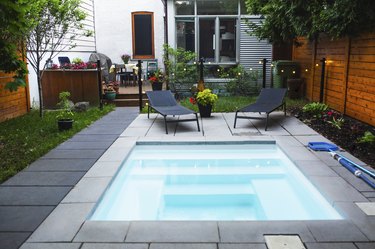
Algae are more or less inevitable in pool water. Green algae are the most common kind, and they will turn the pool water green and cloudy when it rains heavily, if you bring them in on a contaminated swimsuit, or if you lapse in your maintenance routine and let the pool chemicals get out of balance. Yellow (mustard) algae and black algae will also discolor water, but they are more likely to form clumps and cling to things in the pool, and they are more difficult to kill.
The best algaecides for pools usually contain copper compounds, and the reason they kill algae is something of a mystery. They do in fact work, however, although you don't always need them when you think you do. Sanitizing the pool with chlorine is actually a more effective way to control green algae than adding an algaecide, although the algaecide won't hurt. If you have a problem with yellow or black algae, getting rid of them may prove to be a tough job.
Video of the Day
Video of the Day
Adjust pH to Support Chlorination
If you wake up one day and find your clear pool water has developed a green tinge, it's a pretty clear sign that the chlorine isn't disinfecting as well as it should. It may be because there isn't a high enough concentration, but it could also be because the pH is off. It should be in a range from 7.3 to 7.6, and if it's higher or lower than that, the sanitizing effect of chlorine is inhibited.
The first step in getting rid of the algae is to adjust the pH. If it's too high, add muriatic acid to the water to bring it down, and if it's too low, add baking soda or soda ash to bring it up. Once the pH stabilizes at the proper level, you're ready for the next step, which is to shock the pool to raise the chlorine concentration to well over the recommended value of 3 parts per million (ppm). The easiest way to do this is to add pool shock treatment, and the standard amount is 1 pound per 10,000 gallons of pool water, but check the label of the product you use to be sure.
Add Algaecide After Shocking
You may notice that the green discoloration in your pool water has disappeared after shocking, in which case adding an algaecide may be redundant. It won't hurt, though, and it will definitely help if the discoloration hasn't gone. Wait for the pH to fall to a safe level for swimming (3 ppm or below) and then add a product such as Pool Time Algicide + Clarifier in the amount recommended in the product instructions.
Pour this incrementally into the water as you walk around the pool. The product needs time to dissolve into the water and get circulated by the pool pump. As the algaecide kills the organisms, the pool clarifier condenses their bodies into larger clusters that can be removed by the pool filter, so it's important to clean the filter a day or so after treatment. You can repeat this treatment if the green discoloration remains, but don't add too much because it can make the pool water foamy, and it's a skin irritant.
Getting Rid of Black and Yellow Algae
Unlike green algae, black and yellow algae are chlorine resistant, and algaecides aren't strong enough to kill them. You actually have to scrub and vacuum these algae to remove them, so a lot more work is involved. A successful regimen includes a round of scrubbing and then balancing the pool chemicals and scrubbing again. Finally, you need to triple shock the pool and scrub once more to finally be rid of them.
Fortunately, these algae aren't as common as green algae. Adding algaecide to the pool water periodically can help prevent black, yellow, and green algae from getting a foothold in the first place. You also have to observe proper sanitary practices, such as showering and cleaning swimsuits before swimming, maintaining the water chemistry, and shocking the water periodically.